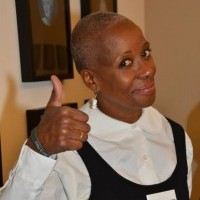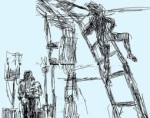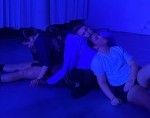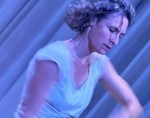
Ronald K. Brown/Evidence: Dancing Through the Spirit
by Rhonda Moore
During a recent phone interview, Ronald K. Brown shared with me a story. “A woman came up to me after a performance and immediately told me that she is an atheist, but nevertheless experienced joy, compassion, and a great sense of fulfillment from my work. She was marveling at how this could be possible, then asked me, ‘is that okay?’”
This is the first thing that popped into my head as the curtain opened on Torch, the first of four works presented by Ronald K. Brown / EVIDENCE at the Prince Theater. The story stayed in my head, swaddling me in warmth long after the performance, as I made my way home through dreary, wintry streets.
While spanning many topics, Brown’s dances have at their root the very clear intention to acknowledge, honor, and venerate God. The choreographer isn’t at all shy about naming a higher power as font of inspiration and guidance in all his choreographic endeavors. For Brown, God is also the source of all we know and understand, and all things that continue to puzzle.
Brown’s very first dance, created at age eight, was a story about God and the people he encountered in church. “I grew up in the church, with a spiritually connected, encouraging, and positive mother, an amazing grandfather and a great-uncle who was a local preacher in Brooklyn. Time spent around these people definitely left an imprint.” Just over a decade later, a 19-year-old Brown created Evidence, the dance company he has relied upon for over thirty years to tell stories of strength, resilience, consolation, and hope—all through a lens of unswerving faith and belief in a higher power. Mixing traditional, contemporary, and social African, Haitian, and Cuban dance forms with movements and rhythms of jazz, R&B, and spoken word, Evidence weaves stories in allegorical fashion, shining light upon the “essentials” of life—joy, grief, faith, belief, community, and shared experience. Though the movement takes its impetus from the African, Cuban, and Caribbean diasporas, the body language, I found, requires little or no translation. The message and the messengers speak to the heart, with a simplicity only the truth can uphold.
Brown uses linear formations to kindle plot, either through on-the-spot canons, or in movement variations that sweep across the space with rhythmic and geometric exactitude. Torch begins with dancers tightly nestled downstage left, executing a group-assisted lift that raises a single performer high above the others, arms stretched outward and upward, like a flower in blossom. Voices in the background repeatedly whisper “…rain . . . shower . . . breath.” They ask for protection, strength, and power, invocating God through the music (Teddy Douglas & DJ Zinhle, with Bussiwa Gqulu), inviting dancers to “inhabit” the rhythms and pulsations. The formation shapeshifts like the time-lapse photography used to magnify nature’s life cycle, as dancers travel and encounter, group and regroup, moving forwards and backwards through time.
In Ebony Magazine: To a Village (1996), Brown tackles the question of façades. The 72-year-old African-American magazine, founded In Chicago by John Johnson, is the perfect context for a world enraptured by outward appearance and flagrant materialism. All begins as if in a fashion show, with dancers costumed in black tie, inhabiting the stage like pictures in an exhibition. The second scene has everyone draped in relaxed, colorful garb, reiterating some of the earlier staging, and though the clothing is much less pretentious, the dancing reveals a larger truth about the multiple faces of superficiality. News of the unexpected death of a friend provides the grounding element for the dance’s finale, as gravitas and selflessness overtake the village. Embarrassment and shame, then sobriety, flood the dancers’ bodies. Heads inclined earthward and torso-rippling undulations speak of grief and sorrow. The shift in mood turns us inwards.
Able storytellers, Brown and Evidence embrace the West African concept of Sankofa (“return and collect it”): in short, knowing and understanding what has come before in order to develop oneself and best prepare for what is to come. Repeating specific gestures, body postures, and rhythmic patterns, Brown and his dancers show reverence, respect, even awe, for the earth and sky, the old and new, the known and the imagined. It is their way of honoring all things God-given. This willful repetition is another circumstance that directly connects Brown’s artistic vision to fundamental principles of African storytelling. For centuries, African griots have used the repetition of words and rhythms to pass on ancient customs and preserve cultural traditions. Following their lead, Ronald K. Brown urges history forward.
New Conversations, Brown’s latest work-in-progress, already shows deft versatility anchored in a recognizable style. In the two sections presented at the Prince, conversations abound. The blues, greens, oranges, and browns of the sea, sun, earth, and sky are reflected in fluid, suggestive costumes that speak volumes in themselves. Dancers encounter one another in pairs, trios, and circular groupings, repeating an open-armed gesture with multiple intentions: they are acknowledging people and place, leaving themselves open and ready for all genre of encounter. Once again, arms stretch outward and towards the heavens, then to the ground. It is all there—Brown’s familiar interplay between adagio and presto, and lines of dancers moving through the space like time travelers. The language in New Conversations, however, has an arresting subtleness in the movements and rhythm, setting it apart from what has come before. Some of the dancing mimics the sounds of the scored instruments; as a dancer executes a light and lazy parallel sissone, we suddenly notice a flute. There is a delicate, layered lightness about this newest piece that speaks to compositional astuteness, good taste, and thirty years of gathered maturity. Already inviting, this piece promises to be a playful mouthful.
The closing piece, Four Corners, originally created for the Alvin Ailey American Dance Theater in 2013, puts dancers in the role of angelic overseers; caretakers of the winds of time. With hands clasped behind their backs, they shadow and encourage, follow and protect. Inspired by the lyrics of composer Carl Hancock Rux’s Lamentations (music by Rahsaan Roland Kirk and North African vocalist Yacoub), Four Corners moves dancers through grief and resolution with strong, earthy, and full-bodied moves. An eye-catching moment occurs when the four angels dance in a circle in counterclockwise motion, hands extended as if steering a giant compass. This is another story that sheds light on the eternal conflicts: man against man, man against nature, man against himself. Harbored in these questions, and consequently the dance, is the notion of conviction, understanding, and acceptance, for Brown all dependent upon unerring faith: “I trust myself, so I always follow my instincts.” With God as his muse, believing in himself and his craft is a no-brainer.
Ronald K. Brown/Evidence, NextMove Series, Prince Theater, December 14-17, http://princetheater.org/events/ronald-k-brown-evidence/
By Rhonda Moore
December 29, 2017










